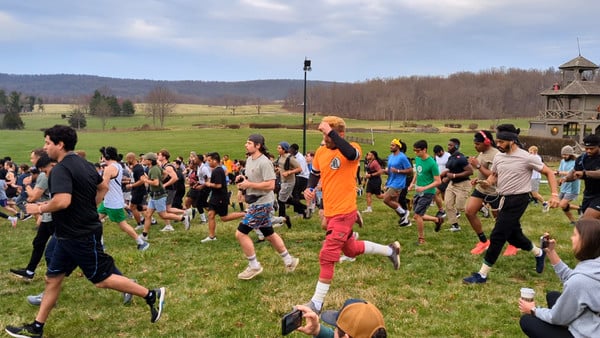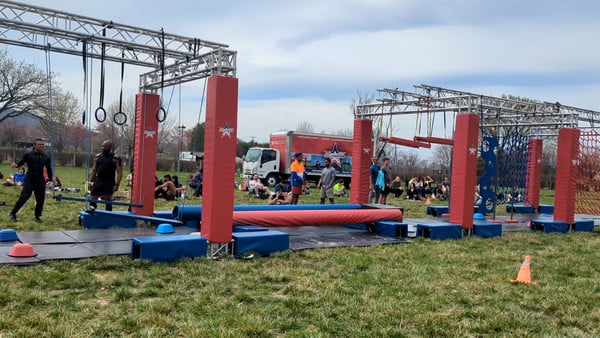Why I Could Never Survive The Real Life Hunter Exam
by Lauren Orsini,
It's 8 AM in the middle of nowhere. Even the closest McDonald's is more than a 15-minute drive away. But more than 1,000 people have gathered at a rural venue that's normally accustomed to hosting equestrian events. Here at Great Meadows in The Plains, Virginia, the first real-life Hunter Exam is about to begin.
Hundreds of cars are parked on gravel and grass. A crowd of people clad in both anime-themed athletic gear and outright cosplay are stretching for the first event, an endurance race with a course and total distance that have been kept secret (but will soon be revealed to be a hilly cross-country slog over eight unpaved miles). Some spectators have brought picnics to enjoy with their children, babies, dogs, and in one case, a parakeet named Sassy.
It's been 27 years since Yoshihiro Togashi's classic manga Hunter X Hunter was first serialized in Weekly Shōnen Jump in March 1998. The globally beloved story's inaugural arc features 12-year-old protagonist Gon undergoing the Hunter Exam, an intense, deadly, and wildly unrealistic test of physical and mental fortitude. To recreate or compete in such an event in real life would be foolhardy, not to mention copyright infringing. But once Matt Dever, 27, and his brother Charley, 24, came up with the idea, they couldn't get it out of their minds.
“'Wouldn't this be great to exist in real life?'” Matt said he recalled thinking. “We thought it was going to be a group of about 20 people in Washington, DC. Long story short, it got picked up on TikTok, Instagram, and elsewhere. We had 500 people sign up overnight.”
Dever and his brother are no strangers to attempting the impossible. The pair was previously in the news for breaking a Guinness World Record for long-snapping a football. So the pair got outside help—sporting events organizer CCSD and a production team of Twitch streamers—to make their fantastical idea a reality. The result: a real-life Hunter Exam that really did take inspiration from Hunter X Hunter. But much like the actual Hunter Exam, this sporting event sometimes felt scary and unfair, like the examiners were making up rules on the fly.
Here are the top three reasons why I could never survive the real-life Hunter Exam.
Huge And Haphazard
The Dever brothers never intended their far-fetched idea to become so huge so fast. Initially, the pair offered free tickets for an event at a venue in a Washington, DC public park. So many people signed up so quickly that they hurriedly closed tickets, reopened and sold them for $40 to $60, and then were inundated again. By the time I registered for my $20 spectator tickets (full disclosure: I received these for free as a press member), participant tickets cost $185.
By the day of the event, more than 1,000 people had purchased tickets to attend the event, but due to various cancellations, Matt estimated that around 800 participants had reached the starting line of Phase 1. Holding the microphone in front of the crowd, Matt, a tall man who looks like he never skips leg day, seemed like he would have been more at home as a participant.

“Step one complete, you found the exam,” he announced to the entra nts, to a scattering of laughs. “What we are about to go through is going to be a test of physical and mental strength that only one percent of you will end up passing.”
Matt was referring to the five stages of the exam, which would vaguely mirror those in the anime. Phase 1: The run. Phase 2: “Assasination,” a riff on flag football. Phase 3: a Ninja Warrior obstacle course. Phase 4: the deception game, Werewolf. Phase 5: “1 on 1 combat,” AKA three stages: tug of war, a memory game, and finally a 1v1 dodgeball tiebreaker. My listing might surprise you if you've been reading articles about the exam. That's because the organizers changed the order of events more times than I could count.
As it turned out, the real-life Hunter Exam was nearly as merciless as the manga version. Shortly after the starting siren went off, one participant was already injured. The problem? The cross-country race began with a narrow gate, and one participant was trampled trying to get through. The event's medical volunteers immediately treated her.
I did not see anyone get seriously hurt during the Hunter Exam, but I did witness unsafe practices. Phase 2, in which Hunters attempted to snatch one another's exam numbers written on yellow flags, involved a lot of grappling and tackling, which was purportedly not allowed.
Another concern: the only water sources for participants were a single spigot in the ground, plus water bottles for purchase from the three food trucks in attendance, each with extremely long lines. An email to participants the day before the exam warned entrants about the weather forecast (which climbed to 80 degrees in the afternoon) and reminded them to “keep hydrated.” But they still might not have realized that water sources at the event were few and far between.
“Where Are The Girls?”
After two hours, Matt ran up to the 8-mile race's finish line with a long rope. “I decide who passes and who fails!” he yelled triumphantly. Once the rope was up, no more runners could pass Phase 1, narrowing the number of participants down from 800 to about 350.
Some participants easily completed the race, with the fastest runners finishing the 8-mile course in 40 minutes. Others ran right down to the wire, finishing after an hour and a half. But by the end of Phase 1, there was a very obvious change in the makeup of the participants—only five women made it through the course.
As runners panted at the finish line, the Twitch chat was alight with comments. “I see no girls, or am I tripping?” one wrote. “[Women] gotta learn to channel Nen,” another commenter wrote, referring to a power system in Hunter X Hunter. In true Twitch chat fashion, the conversation quickly devolved into a discussion I won't repeat here.
Not that the Hunter Exam was ever about fairness, but there is a fair solution to this problem for the taking. The issue comes down to the way racing events usually work. Sign up for a local 10k race, and the organizers will ask for your name, age, and gender. You'll wear a race bib, a special number with a sensor on it to track when you cross the start and finish line. Here's an example of my own race results. I was the 97th person across the finish line. But I was the 27th woman to finish. In other words, I can run competitively among women, but I stand no chance against a man with an identical training plan.

In this way, the real-life Hunter Exam was similar to the show in that it made no exceptions for gender or age. But in the real world, that meant it skewed very male and very young very quickly. Perhaps in a future exam, the organizers could put one of the mental challenges sooner to even the playing field. But I see why they didn't do that—it was hard enough for the 100 volunteer examiners, who had only been briefed on their duties day-of, to referee five simultaneous games of Werewolf.
I immediately recognized one of the five women to make it through Phase 1 as Melody, a college student who made a video about her participation in advance. She was quickly tackled in Phase 2 by a much larger participant and was out of the game.
A Cheater's Paradise
Although the Hunter Exam took place in the middle of nowhere, the Devers purchased Starlink to ensure the many streamer participants and observers were never without a Twitch connection. From the production tent, in which three streamers, David Thompson, Zach Penrice, and Malcolm Crawford, provided commentary and interviews with examinees, to field photographers on the scene, professional-level filmwork showed the finishers both on the ground and via drone footage, capturing every aspect of the exam phases in crisp 4k.
This also means that every instance of cheating was captured on video, plain as day, whether you observed in person or at home.
"There's been cheating in every phase, but if you think about it, that's what a Hunter would do," one of the streamers observed on Twitch. They're not wrong; the fictional Hunter Exam was all about finding ways to bend the rules to your favor. But in the real-life exam, cheaters made the event more confusing and more complicated.
Cheating was rampant in every phase, beginning with the run. At the four-mile mark, runners were given a pipe cleaner to hold, indicating they had gotten far enough to the halfway point. This caused its own problems. One runner dropped his pipe cleaner and had to go back for it, resulting in a finishing time just shy of passing. Others bragged that they never got the pipe cleaner, weren't asked to show it at the finish line, and certainly didn't volunteer.
People who failed Phase 1 competed in Phase 2 anyway. Ditto for Phase 3, making each event take much longer than scheduled. By noon, the entire event was running 2 hours behind. Though the exam was scheduled to conclude at 5 PM, it actually ended up ending along with the fading daylight after 7 PM.

Speaking of Phase 3, to even the playing field, this phase was initially supposed to give participants a choice between completing an escape room or an upper-body heavy timed Ninja Warrior course. But since examinees were using the venue's speedy internet connection and real-time Twitch stream to watch rivals complete the escape room, it became a non-starter. Everyone lined up for the Ninja Warrior course, causing it to take twice as long as planned.
Cheating was just one example of the exam's ruthless unfairness. Later in Phase 2, a participant successfully obtained another examinee's flag but dropped his own. He was eliminated on the spot, despite an argument with volunteers. I could relate to his frustration. Different rules seemed to apply to different people. Some examiners policed grappling, others didn't, and none of them had whistles to stop bad behavior without a fight.
As the sun set, nine people triumphantly received shiny silver Hunter Licenses. As Matt handed out the cards, I realized his speech at the day's beginning had been slightly wrong. They won those hard-earned prizes not only by their own feats of physical and mental strength, but through a modicum of luck, too. Even the strongest participant could have stumbled on the obstacle course or have been voted out in Werewolf. I saw both of those things happen.
"One thousand people signed up, 800 had the balls to show up, and nine became Pro Hunters,” Matt announced to applause from a dwindling crowd. The exhausting event lasted 12 hours in all. Pro Hunters could scan the QR codes on the back of their licenses to enter a special portal on the Hunter Association website. As to what's there, only they and the Dever brothers know. This giant anime fan field day was a festive celebration of the crowd's mutual love for Hunter X Hunter. It was not without its issues, but it's a miracle that this unofficial, hastily planned event happened at all.
discuss this in the forum (11 posts) |